Buying beef cattle for profit can be a gratifying business. However, to make them profitable, you have to manage the various resources well, such as the land, feed, labor, and capital.
How much does it cost to buy beef cattle? According to Beef Cattle Market, the cattle price starts at $109.25, depending on its breed. For instance, a black Angus cow can be purchased at around $800 to $3,000 per cow, while the Simmental breed price ranges from $653 to $1,100.
In this guide, we will further discuss the type of cattle to buy, including the factors to consider when you decide to buy beef cattle. We will also cover the profitability of raising beef cattle, etc., so you better hold on to your seat!
Is Raising Beef Cattle Profitable?

In general, beef cattle are the most profitable and most manageable livestock to grow for profit. They simply need good pasture, fresh water, vaccinations, plenty of room to wander, and extra hay during the winter.
You can purchase calves from your local dairy farms cheaply to start growing beef cattle. To maximize your beef cattle profitability, make sure to pick the right breed to raise, such as those known to provide good revenues.
Having said that, some of the best cattle breeds known to produce substantial profits are Angus, Hereford, Limousin, etc. For instance, a Hereford yearling costs around $800 to $1,500 with an average calf revenue of $608 per cow.
What Is the Best Beef Cattle to Buy?
Typically, the sole source of your revenue from a beef operation will come from the calves delivered each year. So, your cows must bear a calf each every 12 months.
That’s why you must be mindful of choosing and maintaining good productive cows to deliver a calf each year. Ensure to keep their body condition well without becoming extremely thin or fat.
Raise a calf that has an average weaning weight of 155 pounds, meeting your objectives and market demands. Another thing to consider when choosing cows is their breed group. This can either be maternal or terminal breeds.
Generally, beef cattle are split into two distinct groups—maternal breeds and terminal breeds. Maternal breeds are renowned for their mothering ability and milk production, while terminal breeds are noted for their meat-producing ability and growth.
Nonetheless, some breeds are known to both have outstanding maternal characteristics and meat production.
Choose beef cattle traits that are significant to you, and then pursue a breed or a cross-bred that displays those preferred traits. Some of the cattle options you have are the following:
Simmental
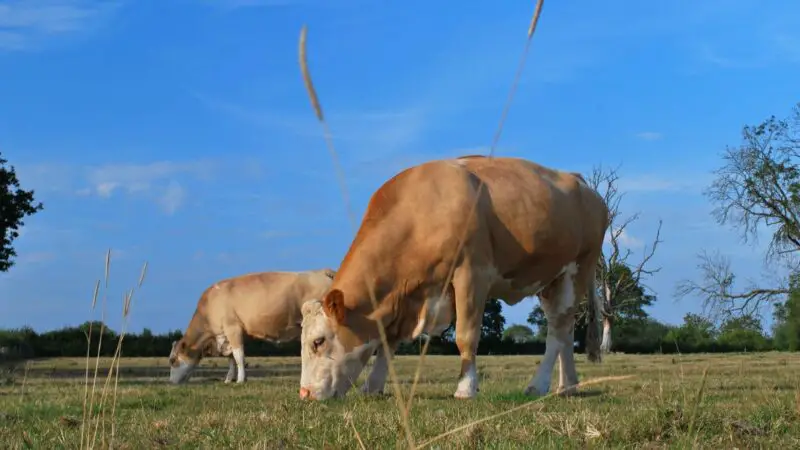
Simmental is a swiss breed cattle with a reputation of being good at calving. This breed is highly adaptable with over 41 million population, showing how satisfying this breed is around the world.
It is named after the Simmental Valley located in Switzerland’s Bernese Oberland. It’s reddish in color with white markings.
This cattle breed is raised for meat and milk and is second to the largest breed next to Brahman. They’re especially well-known for the fast growth of their young, given that they’re fed sufficiently.
Simmentals deliver more weaning gain and milk products than any other cattle breed. The Simmental bulls and cows are best-suited for nearly all types of climates.
They can both survive nicely in countries with pretty high temperatures and in those where the winters are harsh.
- Appearance: Simmental cattle range from yellowish-brown to dark red, having white markings on the belly, brisket, head, and legs. They usually have red pigmentation near their eyes and white patches on their body.
- Lifespan: 10 to 12 years
- Size: 59 to 62 inches tall for male (bull) and 53 to 59 inches tall for female (cow), 2400 to 2800 pounds (1091 to 1273 kg.) for matured bulls, and 1600 pounds (727 kg.) for grown cows
- Color: Black, gold and white, white and red
- Place of Origin: Switzerland
- Characteristics: Simmental cattle can either be polled or horned. If polled, this means they’re without horns, even if they come from livestock that is typically horned.
Horned ones are those with upturned horns. Another distinctive trait of Simmental is that they have a heavy dewlap and a large frame with good muscling. They’re approximately 59 to 62 inches tall for males (bulls) and 53 to 59 inches tall for females (cows).
Limousin
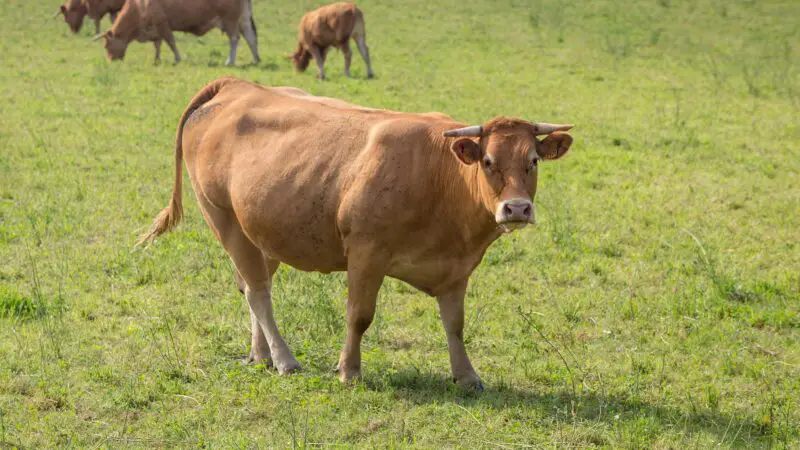
The Limousin is another cattle breed that has a small forehead, short neck, reddish-gold body color, and lighter circles close to its eyes and muzzle.
They also weigh extra during weaning due to their genetics. Limousins have become famous due to their ease of calving, ability to deliver lean, tender meat, high feed conversion efficiency, etc.
- Appearance: This breed has a reddish-gold body color and lighter circles close to the eyes and muzzle. In addition, they have a short neck, a small short head, and a broad forehead.
- Lifespan: 7 to 8 years
- Size: 55 to 61 inches (140 to 155 cm) for males and 53 to 57 inches (135 to 145 cm) for females (height), 2204 to 2866 pounds (1000 to 1300 kg) for males, and 1433 to 1873 pounds (650 to 850 kg) for females (weight)
- Color: Reddish gold
- Place of Origin: France
- Characteristics: The Limousin cattle is reddish-gold in color with lighter circles close to the eyes and muzzle. In terms of size, they’re medium to large frames, with a small head, long body, and pale hooves and horns. Furthermore, they’re heavily muscled, with a high growth rate, high meat yield, and feed efficiency.
Gelbvieh
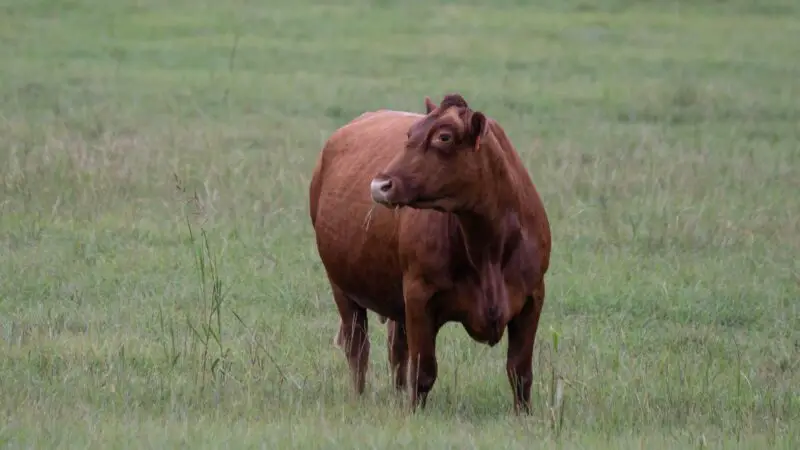
Gelbvieh, also known as Yellow cattle, is a local dual-purpose cattle breed that originated from Germany. The first cattle’s color was yellow-brown with dark hooves.
Through breeding, black and polled Gelbvieh cattle are now typical. These cattle are known for their high maternal efficiencies, traits, and puberty age.
Moreover, Gelbvieh is a muscular breed not too different from Charolais, Limousin, Simmental. These cattle have a highly aggressive temperament, particularly if enclosed in tight areas.
They’re initially horned, but most of them are now polled. In addition, they’re known for their docility, feed efficiency, high rate gain, speedy growth, fast maturity, leanness, loin, and longevity.
They can also adapt to many various climate conditions and rangelands. Females are exceptionally maternal with stronG mothering instincts, good udders, fertility, and strong milk production.
They also have smaller-bodied calves, making it easier for calving.
- Appearance: The Gelbvieh is a medium-sized, European, maternal breed, with a generally short coat and reddish-gold to black or russet color. This breed also has strong skin pigmentation and fine hair, making them ideal to raise in moderate to arid conditions.
- Lifespan: 5 years
- Size: 1000 kg for males (mature bulls), 750 kg for females (mature cows) on average, and 37.5 kg for calves at birth.
- Color: Red to yellowish-red
- Place of Origin: Germany
- Characteristics: The breed is reddish gold to russet or black, with firm skin pigmentation and good hair, making them ideal in temperate to arid conditions. They’re medium to large with a long body and above-average muscling.
Hereford
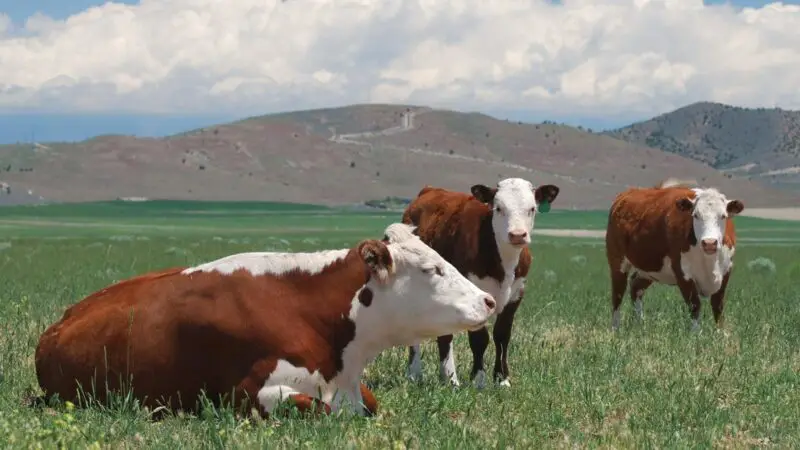
The Hereford breed is known for its excellent maternal qualities and high-quality milk. Its temperament is also more docile, making it easier to manage than other cattle breeds.
They’re also known for their stamina and foraging ability, and longevity. The cows (females) live and deliver calves past 15 years of age, and the bulls (males) remain profitable at studs up to the age of 12 or more.
These big and strong creatures are patched with red and white color, with males weighing around 1,800 pounds, while females are 1,200 pounds. Most of this cattle breed is horned.
- Appearance: The modern Hereford has dark red to red-yellow color, with a white crest, dewlap, underline, and face. Herefords with white markings and white flanks below hocks and knees are also common.
- Lifespan: 15 years
- Size: 1,800 pounds for mature males and 1,200 for mature females (weight), 59.8 inches for males, and 55 inches for females
- Color: Rust brown to rich red
- Place of Origin: England
- Characteristics: These cattle have medium to large build with rust-brown to rich red color. They also have a white face, dewlap, crest, and underline. This breed is also generally docile and fast-growing with satisfactory beef quality.
Angus
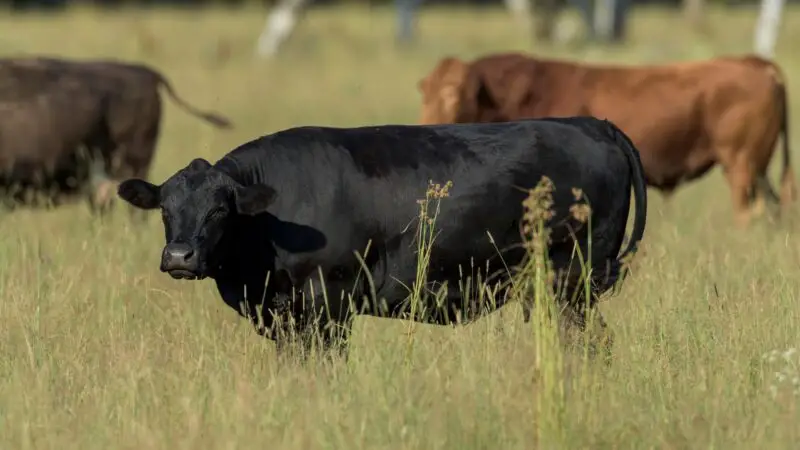
Angus cattle are a moderate-sized muscular breed, recognized as a carcass breed. They’re widely used in crossbreeding to enhance milking ability and carcass quality.
The Angus cattle are also highly prized for beef production due to the tender and flavorful meat they yield. Moreover, the cattle of this breed carry their fat in two manners—marbled in specks or strips throughout their meat or a thick outer layer.
The females of this breed have good calf rearing capability and are used as a genetic dehorner since the polled gene is handed on as a predominant trait.
- Appearance: The Angus cattle have a solid black with a small portion of white on the underline, just after the navel scar. They also have a polled head, packed and low-set body.
- Lifespan: 10 to 12 years
- Size: 1,870 pounds for males and 1,200 pounds for females (average weight), 57 inches for males and 53 inches for females (average height)
- Color: Black
- Place of Origin: Scotland
- Characteristics: These cattle are colored black, with a polled head, consolidated, low-set body, and fine flesh quality. They’re also adaptable, good-natured, undemanding, and resistant to harsh weather. Furthermore, they also mature too early and have a high carcass product with well-marbled meat.
What to Consider in Buying Beef Cattle? | A Detailed Guide
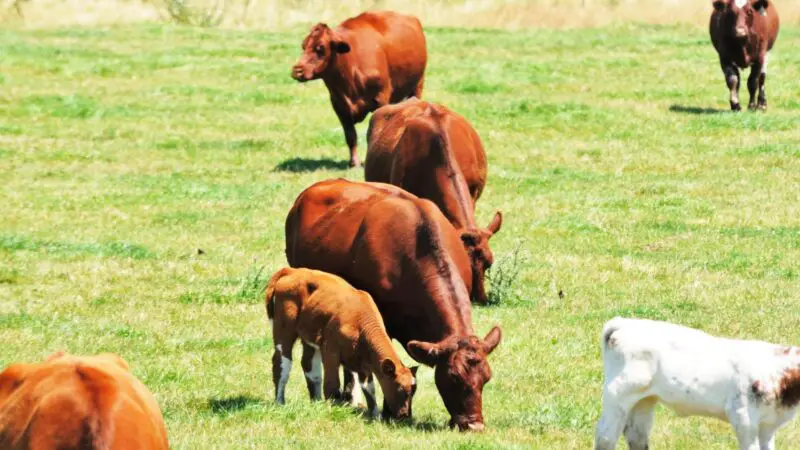
Whether you’re buying beef cattle for a small operation or a large one, choosing the right one is essential to avoid wasting resources. Some considerations that you need to take when buying beef cattle are:
Muscling
Muscling is vital in the meat industry, so you have to check the beef cattle if they have good muscling before buying them. Heavy-muscled cattle deliver more meat and lesser fat, making it in demand in the meat industry.
As you might already know, most consumers are very fat-conscious and prefer their meat to have less fat, according to PMC Labs. You can see the muscling indications over the animal’s back, in the round and the stance width.
Growth and Frame
The ideal live weights in the beef industry are around 1,250 to 1,400 pounds, and the carcass weighs approximately 700 to 900 pounds.
The growth and frame (height) of a cattle is essential to consider since it’s closely linked to the maturity type, which can be used to classify or categorize the cattle based on its growing and fattening pattern.
Indicators of the cattle size are the length and size of the cannon bone, body length, and hip length.
Balance, Soundness, and Structure
Another thing to look at when buying beef cattle is the skeletal structure of the cattle. This is essential for any animals constantly moving to feed and water.
You can get good at the structure at the shoulder angle, top line & hip levelness, animal movement, and the pastern angle. As you can tell, balance is the overall attractiveness of an animal from the front to the rear.
Condition and Trimness
The condition and trimness (fat) of the cattle are other factors that you have to consider before making a purchase. This is because these factors affect the overall performance of the cattle.
Consider purchasing cattle that are not too thin or too fat to ensure that the animal you choose is in good condition. You can see these indications in the flank, brisket, over the ribs, on the pin bones, and in the udder part.
Volume and Performance
The capacity or volume of the cattle is one of the indications of how well they’ll perform as dairy animals. It’s best to go for deep-bodied cattle that can eat large amounts of feed, allowing them to grow and mature early or reach the market weight faster.
Do High-Quality Cows Cost More?
The standard adult cow can cost around $700 to $2,000, depending on the breed. So, you can expect high-quality cows to be more expensive than the standard ones.
What Are the ‘Rock Bottom’ Cow Prices?
Cows can be purchased for as low as $107.67 per hundredweight. (CWT) on average according to Beef Market Central, and can reach up to $123.86 per hundredweight.
The prices will vary, depending on the weight of the cow. If the cow was 800 pounds, given the $107.67 CWT, then the price will be $861.36 since each hundredweight is equal to $107.67 (8.0 x $107.67).
What Variables Affect the Cost of a Cow?
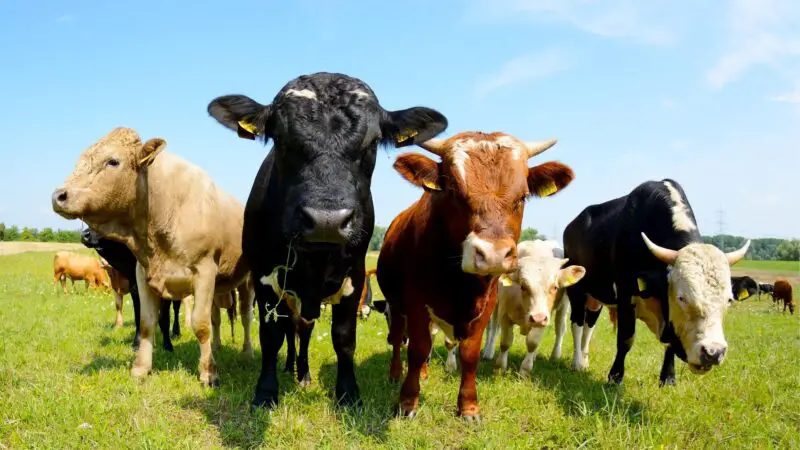
Some of the variables that affect the cost of a cow are muscling, weight, health, frame size, condition, breed, presence of horns, and time of sale. Several physical attributes also indicate different seasonal price effects.
Frequently Asked Questions
Which Is Better, Angus or Hereford?
The beef of Angus cattle is better than Hereford as it has a much higher meat quality. Herefords with white coat color are more inclined to cancers and skin pigmentations.
Angus cattle, on the other hand, are highly resistant to cancers and skin pigmentations since their coats are mostly solid black or red.
How Many Acres Do You Need per Cow?
The rule of thumb is that it requires 1.5 to 2 acres to forage a pair of cow-calf for at least one year. So, 1.5 to 1.8 acres will be enough to sustain a single cow for several months.
What Is the Most Tender Breed of Beef?
The Angus breed has the most incredibly tender, flavorful, and juicy beef. It has a generous marbling, ensuring that every bite is extremely flavorful, remarkably tender, and inherently juicy.
How Many Beef Cattle Do You Need to Be Profitable?
Based on anecdotal evidence, you’ll need 70 dairy cattle or 150 beef cattle to make a decent full-time living from animal farming.
How Long Do You Raise a Beef Cow?
Cows generally achieve their full body weight around two years old, but their body continues to transform after this, so beef cattle are grown until they’re 32 to 42 months old to acquire superior beef fat or muscle structure (marbling).
Summary
Raising beef cattle can be a satisfying farming business. It’s best to note that only a few beef cattle operations are similar to one another, giving producers a variety of possibilities to develop a program that uniquely suits their lifestyle and farming initiative.
Before starting your own beef cattle business, it’s best to see advice from experienced beef cattle producers in your area to ensure that you’ll be doing well in the industry.
List of Sources
Cow-Calf Profitability Estimates for 2020 and 2021 (Spring Calving Herd)
Early Weaning for the Beef Herd
Consumer Preferences for Beef With Improved Nutrient Profile
